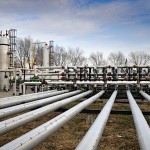Natural gas fell on Friday after jumping by almost 1.5% on Thursday as weather forecasts called for overall mild weather across most of the US in the next several days. However, an upcoming decent warm-up is expected to support prices to the upside as early as next week, although another larger-than-projected weekly build in nationwide gas inventories is to be expected.
On the New York Mercantile Exchange, natural gas for delivery in September traded at $3.807 per million British thermal units at 09:38 GMT, down 0.89% on the day. Prices ranged between days high and low of $3.834 and $3.804. The energy source added 1.45% on Thursday after the EIA reported a smaller-than-expected jump in US gas inventories, to close the session at $3.841. Nevertheless, the power-plant fuel settled the month 14% lower, the biggest decline since March 2012, as widespread mild weather warranted above-average inventory injections.
Natural gas surged on Thursday after the Energy Information Administration reported an 88-billion-cubic-feet jump in nationwide gas inventories. Although the build almost doubled the five-year average gain of 46 billion cubic feet, it fell short of expectations for a jump in the range of 90-94 billion cubic feet.
Total gas held in US storage hubs rose to 2.307 trillion cubic feet, narrowing the deficit to the five-year average of 2.948 trillion to 21.7% from 23.5% a week earlier.
The blue fuel will likely see a sizable injection for next week’s report as well, which will cover the period to August 1, analysts at NatGasWeather.com said. They had predicted a gain of 90-94 Bcf for this week. However, a gradual warm-up starting late this week and extending throughout August is expected to begin lifting prices as early as next week.
US weather
According to NatGasWeather.com’s weather forecast for the August 1 – August 7 period, temperatures over most of the US will begin to gradually edge higher late this week, paving the way for a slightly warmer trend. Currently, readings in the country’s central and southern parts are below normal after an unseasonably cool air mass pushed deep into Texas and the Southeast, ensuring comfortable readings and lower-than-usual cooling demand. As we have reported in the previous days, the western and southernmost areas of the country remain warm to hot, inducing moderate-to-high local electricity demand to power air conditioning.
In the time span between August 8th and August 14th, NatGasWeather.com expects high pressure to set up over the eastern, southern and western parts of the country, with temperatures rising to between 90 and 100 degrees Fahrenheit. The Midwest and Northeast will see readings climbing into the the 80s and lower 90s. However, the countrys northern areas will remain vulnerable to cooler Canadian weather systems that will probably attempt to push into the US around the middle of August. The remaining portion of the country will see warm weather driving seasonally high cooling demand, starting at moderate levels early next week.
Although nationwide cooling demand is currently lower than normal, it is expected to jump to moderate early next week as weather across most of the US becomes warmer, especially in the high-demand states of Texas, Oklahoma and the Southeast.
According to AccuWeather.com, the high in New York on August 3rd will be 77 degrees Fahrenheit, 7 below average, before jumping to 86 on August 6th and as much as 92 degrees on August 15th, 9 above normal. In Detroit, readings will peak at 82 degrees on Sunday, matching the average, and will remain at seasonal or little below seasonal levels through the end of August, apart from several single days with warmer-than-usual weather.
In Texas, the highest-consuming state, Houston will see readings maxing out at 91 degrees on August 3rd, 2 below normal. Temperatures there are expected to remain at around average levels through August 10th, before entering a hot 9-day period, with readings spiking to as much as 99 degrees on August 17th, 6 above normal.
On the West Coast, the high in Sacramento on August 2nd will be 99 degrees Fahrenheit, compared to the average of 92, and the heat is expected to continue through August 16th, with readings surging to as much as 102 degrees on August 12th, 10 above the average.
Technical support and resistance levels
According to Binary Tribune’s daily analysis, in case natural gas for settlement in September penetrates the first resistance level at $3.901 per million British thermal units, it will encounter next resistance at $3.960. If breached, upside movement will probably attempt to advance to $4.031 per mBtu.
If the energy source drops below its first resistance level at $3.771 per mBtu, it will see support at $3.700. If the second key support zone is breached, the power-station fuel’s downward movement may extend to $3.641 per mBtu.





